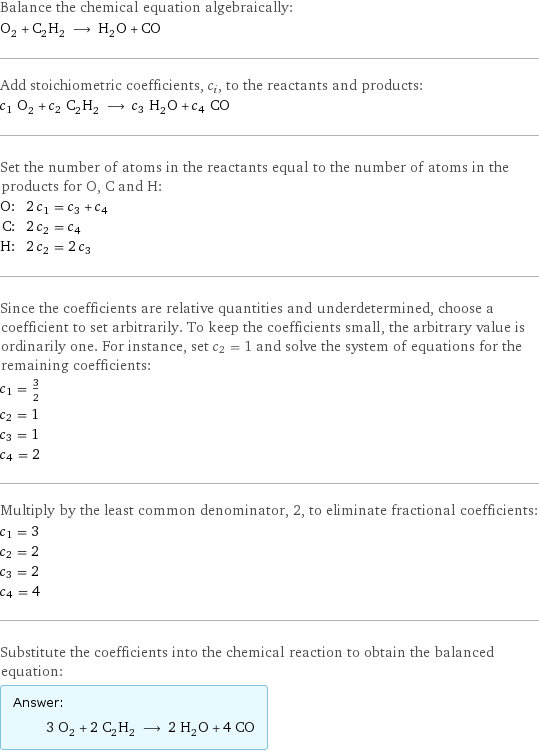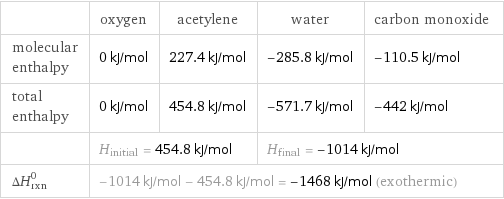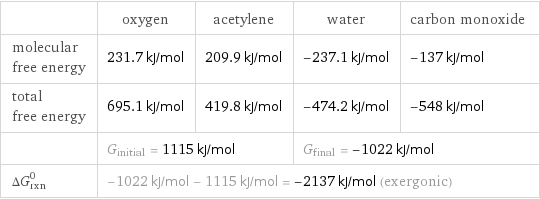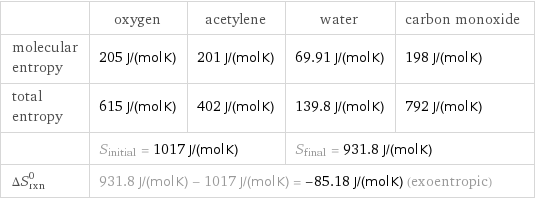Input interpretation

O_2 oxygen + C_2H_2 acetylene ⟶ H_2O water + CO carbon monoxide
Balanced equation

Balance the chemical equation algebraically: O_2 + C_2H_2 ⟶ H_2O + CO Add stoichiometric coefficients, c_i, to the reactants and products: c_1 O_2 + c_2 C_2H_2 ⟶ c_3 H_2O + c_4 CO Set the number of atoms in the reactants equal to the number of atoms in the products for O, C and H: O: | 2 c_1 = c_3 + c_4 C: | 2 c_2 = c_4 H: | 2 c_2 = 2 c_3 Since the coefficients are relative quantities and underdetermined, choose a coefficient to set arbitrarily. To keep the coefficients small, the arbitrary value is ordinarily one. For instance, set c_2 = 1 and solve the system of equations for the remaining coefficients: c_1 = 3/2 c_2 = 1 c_3 = 1 c_4 = 2 Multiply by the least common denominator, 2, to eliminate fractional coefficients: c_1 = 3 c_2 = 2 c_3 = 2 c_4 = 4 Substitute the coefficients into the chemical reaction to obtain the balanced equation: Answer: | | 3 O_2 + 2 C_2H_2 ⟶ 2 H_2O + 4 CO
Structures

+ ⟶ +
Names

oxygen + acetylene ⟶ water + carbon monoxide
Reaction thermodynamics
Enthalpy

| oxygen | acetylene | water | carbon monoxide molecular enthalpy | 0 kJ/mol | 227.4 kJ/mol | -285.8 kJ/mol | -110.5 kJ/mol total enthalpy | 0 kJ/mol | 454.8 kJ/mol | -571.7 kJ/mol | -442 kJ/mol | H_initial = 454.8 kJ/mol | | H_final = -1014 kJ/mol | ΔH_rxn^0 | -1014 kJ/mol - 454.8 kJ/mol = -1468 kJ/mol (exothermic) | | |
Gibbs free energy

| oxygen | acetylene | water | carbon monoxide molecular free energy | 231.7 kJ/mol | 209.9 kJ/mol | -237.1 kJ/mol | -137 kJ/mol total free energy | 695.1 kJ/mol | 419.8 kJ/mol | -474.2 kJ/mol | -548 kJ/mol | G_initial = 1115 kJ/mol | | G_final = -1022 kJ/mol | ΔG_rxn^0 | -1022 kJ/mol - 1115 kJ/mol = -2137 kJ/mol (exergonic) | | |
Entropy

| oxygen | acetylene | water | carbon monoxide molecular entropy | 205 J/(mol K) | 201 J/(mol K) | 69.91 J/(mol K) | 198 J/(mol K) total entropy | 615 J/(mol K) | 402 J/(mol K) | 139.8 J/(mol K) | 792 J/(mol K) | S_initial = 1017 J/(mol K) | | S_final = 931.8 J/(mol K) | ΔS_rxn^0 | 931.8 J/(mol K) - 1017 J/(mol K) = -85.18 J/(mol K) (exoentropic) | | |
Equilibrium constant
![Construct the equilibrium constant, K, expression for: O_2 + C_2H_2 ⟶ H_2O + CO Plan: • Balance the chemical equation. • Determine the stoichiometric numbers. • Assemble the activity expression for each chemical species. • Use the activity expressions to build the equilibrium constant expression. Write the balanced chemical equation: 3 O_2 + 2 C_2H_2 ⟶ 2 H_2O + 4 CO Assign stoichiometric numbers, ν_i, using the stoichiometric coefficients, c_i, from the balanced chemical equation in the following manner: ν_i = -c_i for reactants and ν_i = c_i for products: chemical species | c_i | ν_i O_2 | 3 | -3 C_2H_2 | 2 | -2 H_2O | 2 | 2 CO | 4 | 4 Assemble the activity expressions accounting for the state of matter and ν_i: chemical species | c_i | ν_i | activity expression O_2 | 3 | -3 | ([O2])^(-3) C_2H_2 | 2 | -2 | ([C2H2])^(-2) H_2O | 2 | 2 | ([H2O])^2 CO | 4 | 4 | ([CO])^4 The equilibrium constant symbol in the concentration basis is: K_c Mulitply the activity expressions to arrive at the K_c expression: Answer: | | K_c = ([O2])^(-3) ([C2H2])^(-2) ([H2O])^2 ([CO])^4 = (([H2O])^2 ([CO])^4)/(([O2])^3 ([C2H2])^2)](../image_source/96799ceafb93b86fcc0bd5c958c4888b.png)
Construct the equilibrium constant, K, expression for: O_2 + C_2H_2 ⟶ H_2O + CO Plan: • Balance the chemical equation. • Determine the stoichiometric numbers. • Assemble the activity expression for each chemical species. • Use the activity expressions to build the equilibrium constant expression. Write the balanced chemical equation: 3 O_2 + 2 C_2H_2 ⟶ 2 H_2O + 4 CO Assign stoichiometric numbers, ν_i, using the stoichiometric coefficients, c_i, from the balanced chemical equation in the following manner: ν_i = -c_i for reactants and ν_i = c_i for products: chemical species | c_i | ν_i O_2 | 3 | -3 C_2H_2 | 2 | -2 H_2O | 2 | 2 CO | 4 | 4 Assemble the activity expressions accounting for the state of matter and ν_i: chemical species | c_i | ν_i | activity expression O_2 | 3 | -3 | ([O2])^(-3) C_2H_2 | 2 | -2 | ([C2H2])^(-2) H_2O | 2 | 2 | ([H2O])^2 CO | 4 | 4 | ([CO])^4 The equilibrium constant symbol in the concentration basis is: K_c Mulitply the activity expressions to arrive at the K_c expression: Answer: | | K_c = ([O2])^(-3) ([C2H2])^(-2) ([H2O])^2 ([CO])^4 = (([H2O])^2 ([CO])^4)/(([O2])^3 ([C2H2])^2)
Rate of reaction
![Construct the rate of reaction expression for: O_2 + C_2H_2 ⟶ H_2O + CO Plan: • Balance the chemical equation. • Determine the stoichiometric numbers. • Assemble the rate term for each chemical species. • Write the rate of reaction expression. Write the balanced chemical equation: 3 O_2 + 2 C_2H_2 ⟶ 2 H_2O + 4 CO Assign stoichiometric numbers, ν_i, using the stoichiometric coefficients, c_i, from the balanced chemical equation in the following manner: ν_i = -c_i for reactants and ν_i = c_i for products: chemical species | c_i | ν_i O_2 | 3 | -3 C_2H_2 | 2 | -2 H_2O | 2 | 2 CO | 4 | 4 The rate term for each chemical species, B_i, is 1/ν_i(Δ[B_i])/(Δt) where [B_i] is the amount concentration and t is time: chemical species | c_i | ν_i | rate term O_2 | 3 | -3 | -1/3 (Δ[O2])/(Δt) C_2H_2 | 2 | -2 | -1/2 (Δ[C2H2])/(Δt) H_2O | 2 | 2 | 1/2 (Δ[H2O])/(Δt) CO | 4 | 4 | 1/4 (Δ[CO])/(Δt) (for infinitesimal rate of change, replace Δ with d) Set the rate terms equal to each other to arrive at the rate expression: Answer: | | rate = -1/3 (Δ[O2])/(Δt) = -1/2 (Δ[C2H2])/(Δt) = 1/2 (Δ[H2O])/(Δt) = 1/4 (Δ[CO])/(Δt) (assuming constant volume and no accumulation of intermediates or side products)](../image_source/62382972b0119ce08e52ab671ed42d46.png)
Construct the rate of reaction expression for: O_2 + C_2H_2 ⟶ H_2O + CO Plan: • Balance the chemical equation. • Determine the stoichiometric numbers. • Assemble the rate term for each chemical species. • Write the rate of reaction expression. Write the balanced chemical equation: 3 O_2 + 2 C_2H_2 ⟶ 2 H_2O + 4 CO Assign stoichiometric numbers, ν_i, using the stoichiometric coefficients, c_i, from the balanced chemical equation in the following manner: ν_i = -c_i for reactants and ν_i = c_i for products: chemical species | c_i | ν_i O_2 | 3 | -3 C_2H_2 | 2 | -2 H_2O | 2 | 2 CO | 4 | 4 The rate term for each chemical species, B_i, is 1/ν_i(Δ[B_i])/(Δt) where [B_i] is the amount concentration and t is time: chemical species | c_i | ν_i | rate term O_2 | 3 | -3 | -1/3 (Δ[O2])/(Δt) C_2H_2 | 2 | -2 | -1/2 (Δ[C2H2])/(Δt) H_2O | 2 | 2 | 1/2 (Δ[H2O])/(Δt) CO | 4 | 4 | 1/4 (Δ[CO])/(Δt) (for infinitesimal rate of change, replace Δ with d) Set the rate terms equal to each other to arrive at the rate expression: Answer: | | rate = -1/3 (Δ[O2])/(Δt) = -1/2 (Δ[C2H2])/(Δt) = 1/2 (Δ[H2O])/(Δt) = 1/4 (Δ[CO])/(Δt) (assuming constant volume and no accumulation of intermediates or side products)
Chemical names and formulas

| oxygen | acetylene | water | carbon monoxide formula | O_2 | C_2H_2 | H_2O | CO name | oxygen | acetylene | water | carbon monoxide IUPAC name | molecular oxygen | acetylene | water | carbon monoxide